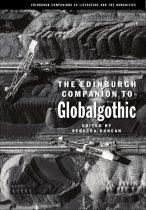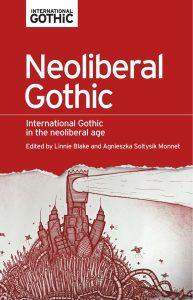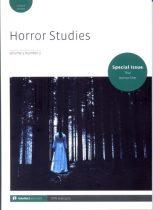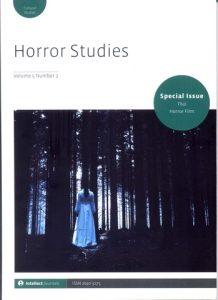2023
 This article discusses three major media forms that drive the globalisation of Asian Gothic: literature originally written in English, film, and original television series created specifically for global SVOD platforms like Netflix, Amazon Prime or HBO Go. The article focuses in more detail on three texts: a novel Ponti (2018) written by a Singaporean author Sharlene Teo, discussed in a larger context of texts featuring a Malay monster known as the pontianak; a Taiwanese film The Tag-Along (Cheng 2015) examined in relation to other East Asian films that feature forest-dwelling child-like spirits/demons that imitate human voice and lure their victims into the wilderness; and an Indonesian mini-series Halfworlds (2015) produced by HBO Asia and directed by Joko Anwar, which will be situated in the context of the director’s overall engagement with folk horror. The article argues that such productions promote an understanding of globalgothic in terms of texts that reconfigure elements of Gothic in order to negotiate transnational relationships from the socio-historical or cultural vantage point of a certain region, in this case the regions of East and Southeast Asia, and that these texts are to a large extent the results of specific production and distribution practices and strategies characteristic of global media.
This article discusses three major media forms that drive the globalisation of Asian Gothic: literature originally written in English, film, and original television series created specifically for global SVOD platforms like Netflix, Amazon Prime or HBO Go. The article focuses in more detail on three texts: a novel Ponti (2018) written by a Singaporean author Sharlene Teo, discussed in a larger context of texts featuring a Malay monster known as the pontianak; a Taiwanese film The Tag-Along (Cheng 2015) examined in relation to other East Asian films that feature forest-dwelling child-like spirits/demons that imitate human voice and lure their victims into the wilderness; and an Indonesian mini-series Halfworlds (2015) produced by HBO Asia and directed by Joko Anwar, which will be situated in the context of the director’s overall engagement with folk horror. The article argues that such productions promote an understanding of globalgothic in terms of texts that reconfigure elements of Gothic in order to negotiate transnational relationships from the socio-historical or cultural vantage point of a certain region, in this case the regions of East and Southeast Asia, and that these texts are to a large extent the results of specific production and distribution practices and strategies characteristic of global media.



 The article analyses the representation of organ harvesting and trade/trafficking in eight post-2000 Asian films. It discusses the films’ consistent portrayal of transplantation as dependant on criminal networks and activities, and their critique of neoliberal medicine as responsible for deepening the economic divisions within Asian societies. The article argues that regional organ trade operates in accordance with the same principles as the global one, allowing for an identification of donor and recipient zones specific to Asia and directing the local organ flows towards the economically privileged Asian countries, such as Japan, Taiwan or South Korea, three countries identified as major beneficiaries in the films. Last but not least, the essay offers a reading of the potentially gothic figures of vengeance appearing in the films (ghosts, resurrected neo-humans, victims-turned-abusers) in terms of a narrative strategy of resistance devised to empower the oppressed.
The article analyses the representation of organ harvesting and trade/trafficking in eight post-2000 Asian films. It discusses the films’ consistent portrayal of transplantation as dependant on criminal networks and activities, and their critique of neoliberal medicine as responsible for deepening the economic divisions within Asian societies. The article argues that regional organ trade operates in accordance with the same principles as the global one, allowing for an identification of donor and recipient zones specific to Asia and directing the local organ flows towards the economically privileged Asian countries, such as Japan, Taiwan or South Korea, three countries identified as major beneficiaries in the films. Last but not least, the essay offers a reading of the potentially gothic figures of vengeance appearing in the films (ghosts, resurrected neo-humans, victims-turned-abusers) in terms of a narrative strategy of resistance devised to empower the oppressed.
 If we agree that globalization translates into a quick and massive flow of capital, people, products, services and ideas across borders then cinema has been a global enterprise since its very beginnings. While local film industries may not share the global distributing potential of Hollywood, this does not mean that their production and post-production methods lag behind. The case of Thai film is not so different here, negotiating the dynamics of the global (e.g. filming equipment, skilled crew, or distribution formats) and the local (e.g. conceptualization, scriptwriting, or narrative formation). Contemporary Thai horror film has long been Thailand’s calling card on international film markets. Known in Thai as nang phi (ghost films), the films remain faithful to their narrow supernatural formula focusing most commonly on the figure of a vindictive phi tai hong (a spirit of the violently dead). Recently, however, the familiar anthropomorphic renditions of ghosts known from older Thai horror films seem to undergo the steady process of de-materialization and de-literalization, challenged through the intervention of technology and reappearing as critically constructed metaphors. This article argues that this change in the way these ghosts are portrayed on film can be seen as a result of the increasing globalization of Thai film industry per se, as well as a reflection on the broader economic, political and social transformations brought about by the powers of globalization in Thailand.
If we agree that globalization translates into a quick and massive flow of capital, people, products, services and ideas across borders then cinema has been a global enterprise since its very beginnings. While local film industries may not share the global distributing potential of Hollywood, this does not mean that their production and post-production methods lag behind. The case of Thai film is not so different here, negotiating the dynamics of the global (e.g. filming equipment, skilled crew, or distribution formats) and the local (e.g. conceptualization, scriptwriting, or narrative formation). Contemporary Thai horror film has long been Thailand’s calling card on international film markets. Known in Thai as nang phi (ghost films), the films remain faithful to their narrow supernatural formula focusing most commonly on the figure of a vindictive phi tai hong (a spirit of the violently dead). Recently, however, the familiar anthropomorphic renditions of ghosts known from older Thai horror films seem to undergo the steady process of de-materialization and de-literalization, challenged through the intervention of technology and reappearing as critically constructed metaphors. This article argues that this change in the way these ghosts are portrayed on film can be seen as a result of the increasing globalization of Thai film industry per se, as well as a reflection on the broader economic, political and social transformations brought about by the powers of globalization in Thailand.
